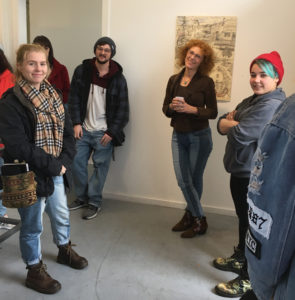Interviews with Artists
In 2017, as part of our ongoing commitment to arts dialogue and education, we began archiving interviews with the artists we have worked with at the Arts Research Collaborative. It is our hope that the collected conversations will continue to be a vital resource for all who visit.
From 2018-2019 UML student Dana Cram worked as an intern and preparator for the ARC. He interviewed Heather Pereira in September 2018.
In your artist statement for Thalassic Park, you offer that you began this period in your art making in a brand new life. As time passed while you worked through your pieces, how did you settle into your family, home and daily routine? Did you always feel your creation aiding the process, or did it sometimes reinforce the disparity between your ‘old world’ and new?
HP: The artwork was really more about the disparity that I was struggling with, and to some extent, still do. If I’ve settled into a new routine, there will always be nostalgia at times for the familiarity of what was. In general, my artwork seems to show a bit of melancholy. My house and studio are filled with sentimental possessions and it is all too easy to look at something or listen to an old selection of music that will poke at a memory.
The settings and landscapes of your paintings are pieced together, as you describe the building of your sculpture. How do you approach the drafting and organization of the dozens of unreal elements on your two-dimensional planes?
HP: Despite my passion for narrative artwork, I’m very sensitive to and aware of the power of written language. I deliberately play with the double entendre of a given context within my imagery. I’m of the belief that everything an artist creates is a self-portrait. Am I a mariner? Do I like octopi? Do I really have fish tanks? Is that what you are asking me? I think that if you really want to dissect content with me, one has to look beyond the physical depiction. While my work is deeply personal, I think within the construction of a fantastical world, I’ve given the viewer a point of entry. I love the way the subconscious mind operates and I’m not afraid to show you mine.
Most of the “forlorn creatures” of these pieces often have immediate relationships with aquatic life. Where does this apparent fascination surface? How does this theme relate to this show’s work, in particular?
HP: Forlorn creature and the life aquatic let me think about that for a minute. My life aquatic these days is spent in my bathtub. It is undeniably my place of sanctuary and daily refuge. I used to swim a great deal and while I love the ocean from a distance, I adore swimming pools; contained bodies of controlled water, much like my fish tanks. My sea creatures however came about as a reaction to local galleries in this area wanting to know if I had any work that featured ocean themes. Really? Is that the only way I’m going to sell any work in this town is to produce some mindless whales or seahorses? So, I went about researching and sketching and found that my initial drawings were pretty funny. I sketched a skinny girl holding a sand pale and a shovel with a clam for a head, a few sad little mermaids with gorgeous updos and a mustached octopus riding a bicycle. These initial musings lifted my spirits at the time and were what began to envelop my working concept for this series.
Your sculptures appear to be living evidence of the New Mexican tendency to cobble and transform everyday objects. Does their inclusion in the show tie to such a thread, or do they stand in-between, intertwined with corresponding paintings?
HP: You asked about how I piece together images and sculpture and whether the process is related. I tend to believe that they are not. When I create a 2D image, I see it in my minds eye and know, for the most part, how it has to appear and begin rendering it as a sketch. Then I go about the process of finding the objects that I’ve imagined which is at times very easy as I have them on hand and can set them before me as references and inspiration while I draw or paint. If it’s a landscape or an interior, the settings are usually places I have explored, otherwise I’m tracking down objects on the internet or in books. The Assemblages for this series was purposely pieced together because I wanted to use my 1950’s fashion doll bodies, but needed to re-create their heads. I think it is interesting that you picked up on the “cobbled together” aspect of the sculpture and related it to my thoughts about New Mexico, although it was more coincidental.
From the Thalassic Park collection, what piece stands out as the most important, telling, or evolutionary work for your practice?
HP: The most important piece for me in this series was the large scale drawing of my mermaid in the desert. It was a technical challenge because of its size and level of detail, but it also held a lot of narrative leftover ingredients that I had in my head, but never added into the other drawings. I like eating leftovers. Do you? Don’t you love the day after Thanksgiving slightly better than Thanksgiving? That’s how it is with that large scale drawing. It’s the day after Thanksgiving!

